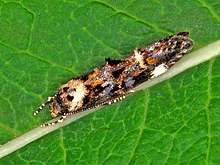Mompha conturbatella
| Mompha conturbatella | |
|---|---|

| |
| Mompha conturbatella. Dorsal view | |
| Scientific classification | |
| Domain: | Eukaryota |
| Kingdom: | Animalia |
| Phylum: | Arthropoda |
| Class: | Insecta |
| Order: | Lepidoptera |
| Family: | Momphidae |
| Genus: | Mompha |
| Species: | M. conturbatella
|
| Binomial name | |
| Mompha conturbatella (Hübner, 1819)
| |
| Synonyms | |
| |
Mompha conturbatella, also known as the fireweed mompha moth, is a moth in the family Momphidae found in Asia, Europe and North America. It was first described by Jacob Hübner in 1819.
Distribution and habitat
This species has a Holarctic distribution. In the Palearctic, it is found from Europe through the Caucasus and central Asia to the Russian Far East.[1][2] The species is also common in North America.[3] These moths mainly occur in mountains, woodland, hedge rows and marshy areas.[4]
Description
Mompha conturbatella has a wingspan of 11–17 mm.[5] Forewings of these moths show stains of various color, ranging from brown to black, bluish, russet and white. On the dorsum are present several raised tufts of scales.[3][4]
Biology
Mompha conturbatella is a univoltine species.[3] Adults are on wing from June to July.[4] They feed on nectar of hogweed (Heracleum sphondylium) and rosebay willowherb or fireweed (Epilobium angustifolium).[6]
The larvae feed on fireweed, dwarf fireweed (Epilobium latifolium) (and possibly broad-leaved willowherb (Epilobium montanum) [citation needed]).[2][4] Larvae can be found from May to June.[3][6] At the end of spring, the larvae live between spun together leaves at the tip of the plant and later into the stem. Pupation takes place in a yellowish brown cocoon in litter on the ground.[5]
References
- ^ "Mompha (Mompha) conturbatella (Hübner, 1819)". Fauna Europaea. Retrieved 23 April 2020.
- ^ a b Savela, Markku. "Mompha Hübner, [1825]". Lepidoptera and some other life forms. Retrieved 23 April 2020.
- ^ a b c d Koster, Sjaak; Sergey, Sinev (2003). Momphidae. In Microlepidoptera of Europe (Book 5). Apollo Books. ISBN 978-8788757668.
- ^ a b c d Kimber, Ian. "40.001 BF885 Mompha conturbatella (Hübner, [1819])". UKmoths. Retrieved 23 April 2020.
- ^ a b "Mompha conturbatella". Naturhistoriska risksmuseet (in Swedish). Retrieved 23 April 2020.
- ^ a b Lindsey, J K. "The Ecology of Commanster". Commanster.eu. Retrieved 23 April 2020.
